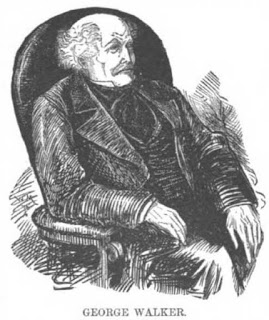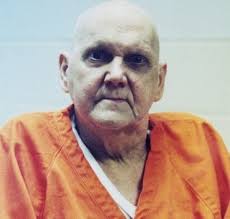George Walker (1803-1879)
George Walker was born on March 13, 1803 in Great Portland Street, London. He was the son of another George Walker (1772-1847). George Walker Senior was a bookseller who also wrote a couple of volumes of poetry and a dozen novels.
George Walker Senior soon became a music publisher only and his son, George, joined the business in Golden Square, 17 Soho Square.
In 1820, at the age of 17, George Walker became interested in chess after reading Sir William Jones’s poem on chess. He learned chess from a cheap copy of Philidor’s chess book that he bought at a book stall.
Walker first took chess lessons from a lady named Madame Jansen Bartolozzi, who was a sister to Walker’s music professor.
George Walker later studied chess under William Lewis (1787-1870).
In 1823, George Walker Junior, along with three other friends, founded the Percy Chess Club at the Percy Hotel in Rathbone Street, Oxford Street. Walker first visited about 50 taverns on the west end of London, but could not get a room to play chess or they would not allow gambling (chess) in the establishment. The Percy Chess Club began with 20 members. The club only lasted two years. Members of the Percy club then migrated to the Lewis Subscription Rooms in St. Martin’s Lane, run by William Lewis. Lewis’s club ended in 1827. One of the early members was Duncan Forbes, the chess historian.
On October 19, 1823, Walker wrote the first known chess column in the Lancet, a medical magazine. His first article was called “Origin of the Game of Chess.” The column lasted a year.
In 1825, Walker’s Percy Club had to fold as the proprietor of the Percy Coffee House did not have enough cash to keep it going. At its peak, it had 40 members.
In 1827, Walker played chess and was a member of the London Chess Club. He also played chess at the Divan.
In 1827, William Lewis was still giving George Walker odds of a rook.
In 1828, Walker translated Traite Theorique et Pratique Du Jeu Des Echecs, first published in Paris in 1775.
In 1829, Walker recorded many of Alexander McDonnell’s chess games. McDonnell took no trouble recording his own games.
From 1828 to 1831, Walker’s chess library contained translations of Cozio, Lolli, Reinganum, and others.
In October, 1829, Walker and William Lewis arranged a match of 21 games. Lewis spotted Walker a knight.
In 1830, Lewis was giving Walker the odds of a pawn and two moves.
In 1831, Walker founded the Westminster Chess Club on the first floor of Huttman’s Coffee House in Bedford Street, Covent Grove. Walker was the secretary and Captain Medwin was the president. Among its members were Rev. A. D’Arblay, Duncan Forbes, the historian of chess, Captain William Evans, and Alexander McDonnell. After a few months, there were 200 members. Membership fee was two guineas. Huttman sold cigars wrapped up in paper, containing diagrams of chess problems.
In November 1831, Chess: New Variations on the Muzio Gambit, was written by George Walker and published in London. It contained 18 pages of analysis of the Muzio Gambit. Walker pointed out that Muzio was not the originator of the gambit, but it was Don Geronimo Cascio that originated it. It was a mistake in the translation by Sarratt in one of his chess books. His pamphlet cost only 18 pence. He later incorporated his analysis in the Art of Chess Play.
In the spring of 1832, the first edition of A New Treatise on Chess, written by George Walker, was published in London. The cost was only 3 shillings, 6 pennies for 80 pages.
Walker’s cheaper chess books started a war between him and William Lewis, in which each writer tried to cut the other’s works by chess books at a lower price.
In 1832, Walker published The Celebrated Analysis of the Game of Chess. It was a translation from the French of Philidor’s chess book. It included 56 more chess problems. The book was dedicated to Alexander McDonnell.
In May, 1833, Walker published a second edition of A New Treatise on Chess. It contained 50 new chess problems. The cost was only 5 shillings for 160 pages.
In 1833, Anweisung Zum Schachspielen (Instructions to Play Chess), by George Walker and Joseph Schiereck, was published in Frankfurt.
In 1834, a match between the Westminster Chess Club and the Paris Cercle was arranged, played for a stake of 100 British pounds. It was won by Paris.
In 1834, Walker arranged the McDonnell-Labourdonnais match, which was played at the Westminster Chess Club at Huttman’s. George Walker and William Greenwood Walker (no relation) took down the moves of the games. William Walker was the secretary of the Westminster Chess Club.
In 1835, Walker was the chess editor for Bell’s Life (founded in 1822). He remained editor until 1873.
In 1835, George Walker advertised in the London Times that he was giving chess lessons at his home. (source: The London Times, May 19, 1835)
In 1835, George Walker suggested the idea that, since the Black pieces were thought to be the lucky color, the players who drew White should always have the first move as compensation. It wasn’t until 1870 when this rule became universally accepted.
In May, 1835, Walker published Selection of Games Actually Played by Philidor and his Contemporaries. The book was dedicated to the members of the Edinburgh Chess Club. The contents of the book were drawn from the chess papers of mathematician George Atwood, which Walker had purchased in 1833.
In March, 1836, J. H. Huttmann reorganized the Westminster Chess Club, ending club dinners and concentrating in chess.
In 1836, Anweisung Zum Schachspielen, volume 2, by Walker and Schiereck, was published in Frankfurt.
In 1836, Walker wrote Chess Made Easy, which was published in London. It was dedicated to the members of the Society for the Diffusion of Useful Knowledge. The cost of the book was 3 shillings, 6 pennies.
In January 1837, George Walker published The Cribbage Player’s Text Book.
In December, 1837, Walker became the editor of The Philidorian, a magazine of chess and other games. It lasted for 6 issues, until May, 1838. It later appeared as a bound book in one volume.
At the end of 1837, Howard Staunton became secretary of the Westminster Chess Club. He remained secretary until the club folded at the end of 1839.
In 1839, Walker visited Paris and the Café de la Regence. He lost a match to Hyacinthe Henri Boncourt (1765-1840), winning one game and losing two games.
In March, 1839, Walker wrote “Deschapelles, the Chess-King,” which appeared in Fraser’s Magazine.
In May, 1839, he wrote “The Chess Automaton” which appeared in Fraser’s Magazine.
In 1840, Walker started the St. George’s Chess Club, but it failed by the end of the year.
In 1840, Walker raised money (over 200 British pounds) to allow Labourdonnais and his wife to move out of squalor and into decent quarters when they moved from France to London.
In 1840, Walker’s chess club, the Westminster Chess Club, moved to new quarters in Charles Street, Haymarket.
In 1840, Walker published Sturges’ Guide to the Game of Draughts. An American edition was printed in New York in 1845.
In 1840, Walker wrote an article called “A Visit to the Café de la Regence” which was published in Frazier’s Magazine.
On December 13, 1840, Labourdonnais died. George Walker paid for the funeral arrangements. Labourdonnais was buried at Kensal Green, next to Alexander McDonnell, who died in 1835. Walker took up a subscription for Labourdonnais’s widow.
In 1841, Walker’s third edition of A New Treatise on Chess was published in London. The book was dedicated to Ada Lovelace. The price was 8 shillings.
In 1841, Walker, in Bell’s Life, described a gathering of Yorkshire players (a chess congress) in Leeds as a “tournament.” It may be the first use of the word for chess events. The term later caught on to the modern meaning of chess tournament.
In 1843, Walker’s Westminster Chess Club dissolved.
In 1843, Walker re-established the St. George’s Chess Club at Beattie’s Hotel, George Street, Hanover Square. Soon, Beattie went bankrupt and the club found quarters in the Polytechnic Institution, in rooms overlooking Cavendish Square. The chess club remained here for 10 years. Howard Staunton joined the St. George’s Chess Club in 1843.
In December, 1843, Walker wrote “The Battles of McDonnell and De la Bourdonnais,” which was published in the Chess Players’ Chronicle.
In February, 1844, Chess Studies: comprising one thousand games, actually played during the last half century, by George Walker was published in London. It was a vast collection of games played from 1780 to 1844. It was all the games of that period that Walker could discover. When the book appeared, Howard Staunton was so indignant at what he called ‘wholesale spoliation’ that he threatened legal action proceedings.
In 1845, Walker teamed up with Buckle, Evans, Perigal, and Tuckett in London in two telegraph games against Staunton and Hugh Kennedy in Portsmouth. Walker’s team won one game and drew their second game.
In May 1846, a fourth edition of The Art of Chess-Play: A New Treatise on the Game of Chess was published in London by George Walker. It was dedicated to the members of the St. George’s Chess Club. The London publisher printed 2,000 copies of his book, but soon went bankrupt. In his book, Walker wrote “the strongest defence is a counter-attack.”
In 1846, Walker defeated Daniel Harrwitz in a match in London, scoring 7-5.
In 1846, Walker wrote “The Celebrated Traite des Amateurs,” published in The Chess Player’s Chronicle.
In 1847, George Walker’s father died. George Walker gave up the music publishing business and became a stock broker.
In 1847, Mr. Hampton took over Walker’s St. George’s Club, and established it in King Street, St. James.
In 1847, Walker translated from the French and published Jaenisch’s Chess Preceptor. The original edition was called Analyse Nouvelle des Ouvertures du Jeu des Echecs, published in 1842.
In 1849, another edition of Anweisung Zum Schachspielen, by Walker and Schiereck, was published in Frankfurt.
In 1850, Walker published Chess and Chess-Players. Afterwards, he withdrew from chess.
In 1851, Walker’s chess club, the St. George’s Club, organized the great International Tournament of 1851.
In July, 1858, Walker consulted with Morphy in a consultation game of Morphy, Walker, and Greenaway vs. Loewenthal, Medley, and Mongredien at the London Chess Club. The game was abandoned due to the lateness of the hour.
On April 13, 1859, George Walker was able to draw Paul Morphy as part of Morphy’s blindfold exhibition in London.
In 1872, George Walker raised money to help out Captain William Evans, who was 82 years old and in poor health, and his wife, who was over 70 years old.
In 1873, Walker gave up his chess editorship in Bell’s Life after 38 years.
On May 14, 1874, Walker sold his chess library of 314 books through auction by Sotheby in 1874. The majority of his chess books were purchased by Rimington-Wilson.
In later life, Walker became partially blind and he retired as a stock broker.
George Walker died on April 23, 1879 at the age of 76. He was buried at Kensal Green.




Comments
Post a Comment